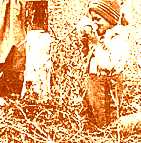



Page Navigation Buttons--- |
|---|
|
|
Nodinens (Little Wind), a Mille Lacs Band Ojibwe from central Minnesota, was 74 in 1910 or so when she told Frances Densmore about sugaring in the old days. She describes going to and building the winter hunting camp for 6 families. The wigwams would be insulated with evergreen boughs, dirt, and snow shoveled onto a framework of logs, covered with birchbark and woven mats. The men would leave for deep woods hunting and trapping. During the winter, women dried meat the men brought in. Then.... Toward the last of winter, my father would say "One month after another has gone by. Spring is near. We must get back to our other work." So the women wrapped the dried meat tightly in tanned deerskins and the men packed their furs on sleds or toboggans. Once there was a fearful snowstorm when we were starting. My father quickly made snowshoes from branches for all the older people.  A toboggan is shown leaning by the door of this winter house. The Anishnaabe word for it is nobugidaban, from nobug, flat, and daban, drag, "Toboggan" is a French mispronunciation of the word. These flat-bottomed snow carriers were made of hard wood, cut during winter when the trees have no sap. The front end is heated by boiling then bent upwards. Usually a rawhide covered the bent front end, to protect riders. Loads were tied onto cleats along the sides. Dogs or several people pulled it from the front. A strap in the rear was held by the driver or a companion running behind as a brake to prevent slides from getting out of control downhill. It required only the width of a woods footpath to carry large loads. Sleds or sledges required wider paths, were harder to pull, usually smaller, constructions made with bodies raised above bent runners. Small ones could quickly be improvised in the winter woods from bent and tied branches, as Nodinens' father did with improvised bear-paw snowshoes. Nodinens continues:
When we got to the sugar bush we took the birch-bark dishes out of storage and the women began tapping the trees. [Ojiguigun were taps pounded into cut wedges, sealed around the spiles with hot pitch (or later drilled) about 3" deep, on the sunny side, about 3' above the roots. Negwakwun were spiles, made of large elderberry stems, with the pith pushed out, sharpened at one end, and notched to hold the sap pail.] We had queer-shaped axes made of iron. (Note: these may have been pickaxes, wqhose points would make more of a hole than a wedge-cut.) Our sugar camp was always near Mille Lacs, and the men cut holes in the ice, put something over their heads and fished through the ice. There were plenty of big fish in those days; the men speared them. My father had some wire, and he made fishhooks and tied them on basswood cord. He got lots of pickerel that way. A food cache was always near the sugar camp. We opened that, then had all kinds of nice food that we had stored in the fall. There were cedar-bark bags of rice, there were cranberries sewed in birch-bark makuks, and long strings of dried potatoes and apples. Grandmother had charge of all this. She made us young girls do the work. As soon as the little creeks opened, the boys caught lots of small fish. My sister and I carried them to the camp and dried them on a frame over the fire in the center of our camp. My mother had two or three big brass kettles (akik)she had bought from an English trader and a few tin pails from an American trader. She used these in making the sugar. We had plenty of birch-bark dishes (biskitenagun, from biskite, ishe bends it, and onagun, a dish) but we children ate mostly from the large shells we got along the lake shore. We had sauce from the dried berries sweetened with the new maple sugar. The women gathered the inside bark from the cedar. This can only be scraped free in the spring. We got plenty of it for making mats and bags later. Toward the end of the sugar season there was a great deal of thick sap called the "last run" (izhwaga zinzibakwud). We also had lots of food we had dried. This provided us with food while we were making our gardens at our summer home.  It takes 30 - 40 gallons of average maple sap -- (zinzibakwudabo, liquid sugar) to boil down to one gallon of syrup. No wonder the birch-bark sap-collection pails were called nadoban, making the word for "she goes and gets" (nadobe) into an object (40 gallons of sap reduces to about 3 quarts of sugar when further heated in a smaller kettle or pail (ombigamizigan). Sugar was made in 2 forms. Thick syrup for hard sugar (zhiiwaagamizigan) was scooped before it granulated from the final boiling kettle, and poured onto ice or snow to solidify. Then it was packed tightly into shells or birchbark cones (zhiishiigwaansag) whose tops were sewn shut with basswood fiber for storage, These were licked and eaten like candy. Sugar cakes were also made in shapes of men and animals, moons, stars, flowers, poured into greased wooden molds. Small pieces of deer tallow were put into the syrup as it boiled down. When the boiled sugar was about to granluate in its final boil-down, it was poured into a wooden sugaring trough, made from a smoothed-out log. It was stirred there to granulate it, and rubbed with sugar ladels and hands into sugar grains, ziinzibaakwad.. Warm sugar was poured from the trough into makuks of birchbark. This was the basic seasoning and an important year-round food, eaten with grains, fish, fruits and vegetables, and with dried berries all year round. In summer, it was dissolved in water as a cooling drink. In winter it was stirred into with various root, leaf and bark teas. The fancy cakes were used as gifts, showing off the maker's originality of design. Maple sugar Only satisfies me In the spring! Anishnaabe song  The sweet birch called black birch or cherry birch and as shown here, in Canada, the white birch (wigwasatig) can be tapped for sap also. These trees run about a month later than maples. They flow much more copiously, a gallon an hour is usual, but the sap is only about half as sweet -- takes twice as much to boil down to syrup and suger, and the run doesn't last as long. The sweet birch called black birch or cherry birch and as shown here, in Canada, the white birch (wigwasatig) can be tapped for sap also. These trees run about a month later than maples. They flow much more copiously, a gallon an hour is usual, but the sap is only about half as sweet -- takes twice as much to boil down to syrup and suger, and the run doesn't last as long.
The photo, taken sometime in the 1860's in Canada, shows a woman collecting birch sap and a child drinking it. Fresh birch sap tastes almost like cold water, just a hint of sweetness, with a slightly minty, wintergreen taste (birch twigs are used to make non-synthetic wintergreen flavoring). In late spring, birch sap could be a useful drink for a traveler in marshy areas, where there was no pure water at hand. To make sugar of it, though, took twice as much sap and twice as long to boil it down. Birch syrup (which is rather like molasses) and sugar have no hint of the wintergreen flavor; it is volatile and is driven off by boiling. Wintergreen-flavored tea is made from fresh spring twigs steeped (but not boiled) or from under-bark scraped and carefully dried in the shade. Birch bark comes in many different thicknesses, depending on the age of the tree, which Winabozho gave to be a protection and benefit to the people, after it had saved him from the thunderbirds (whose child the birch tree is). Thick bark for making canoes may be 6 - 9 layers thick. Thinner bark may be almost like tissue, but is very tough, and usable for wrapping small packets. Birch bark lasts a very long time (especially if buried in earth). Trays and oontainers in heavy use might last for 10 years or more, especially if repaired with balsam gum (coatings of which reinforced twine sewings). Birch bark has some unidentified biological property that lets it preserve foods stored in it, for example gummy sugar in birch would keep for 2 years or more. Partially dried vegetables, fruits, pressed cakes of berries, though not sterilized by boiling (as in preserving or canning) all could be stored tightly wrapped in it for years. Though birch bark is highly inflammable, freshly cut with its wet inner surface turned outward, it can be made into a cookpot, where stews or soups are boiled without burning up the wet bark. Winabozho made all the little short marks on the outside of birch bark, while hiding in the "king log" from thunderbirds whose feathers he had stolen. But birch bark also contains little pictures of these amiinkiig that can be seen very well on some special white birch trees. Birches are always thanked with tobacco whnever any of their gifts are used.  All stages of maple sugaring were painted by Minnesota Red Lake Ojibwe Patrick DesJarlait. See his and his son Robert's pictures, and read a little more about sugaring; then return here with your GO-history button or BACK button to read about wild rice.Recommended reading, grades 3-6: Ininatig's Gift of Sugar: Traditional Native Sugarmaking, Laura Wateman Wittstock, photos by Dale Kakkak. $19.95 hardcover, $6.95 paper, discounts to schools. Lerner, Minneapolis, 800/328-4929. Lerner publishes a series of Native-centered social studies books for elementary children, and several for young adults. These are done either by native authors (as Laura and Dale are) or in careful consultation with the tribal group (Mille Lacs in this case) whose real-life story is told. You can buy this book on-line, discounted from amazon.com: Ininatig's Gift of Sugar : Traditional Native Sugarmaking (We Are Still Here : Native Americans Today); Laura Waterman Wittstock, Dale Kakkak (Photographer); Library Binding; $19.95 And for fascination adult reading: Chippewa Customs (Publications of the Minnesota Historical Society); Frances Densmore; Paperback; $9.95 |
|---|

Custom Search
|
 TOP of TOP of Page |
 WILD WILD RICE |
 NATIVE NATIVE FOODS |
 --MAIN --MAIN MENU |
|---|
CREDITS: The canoe logo was drawn by me (FreeHand) in 1994 to use on a flyer for a Heart of the Earth Native Science Project-sponsored stortytelling about Wild Rice by a project staffer. For these web pages, I added a big harvest moon and colored it. Credits for the paintings and drawings used in the "Desjarlait" section linked-to here are on the Minnesota Indian Artists page, which honors the Red Lake Ojibwe Pat DesJarlait and the DesJarlait artist-family. Several old photos or drawings here are from Canada SchoolNet's CanaDisk image library.
Others were scanned by me from Frances Densmore's Chippewa Customs, material she collected from 1905-1925 (U.S. Bureau of Ethnography) which was reprinted in hardcover by Ross and Haines Old Books, Minneapolis, 1970, long out of print (a defunct company). Nodinens story about maple sugaring is taken from there. Densmore's How Indians Use Wild Plants for Fooid, Medicine & Crafts compiled over the same priod as her other Ojibwe books is the source of some photos of sugaring and ricing tools.
Webmistress --Paula Giese.Text and graphics copyright 1995.
Last Updated: 6/6/97